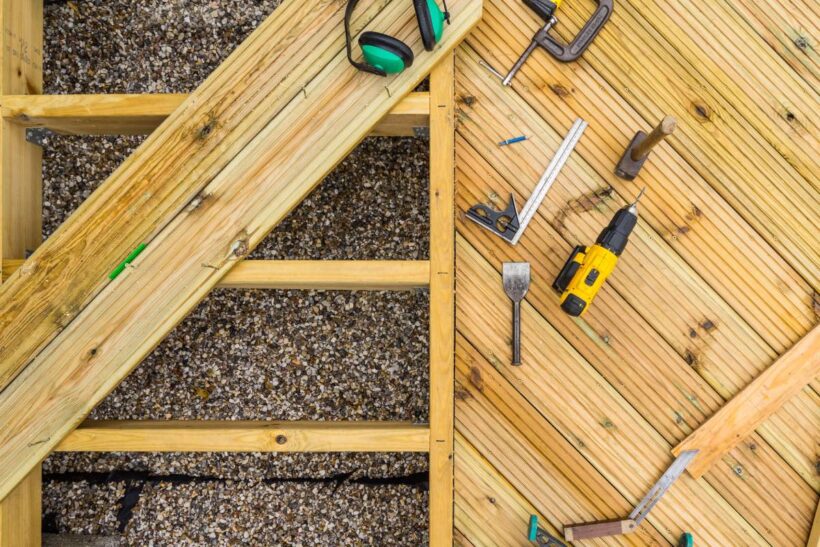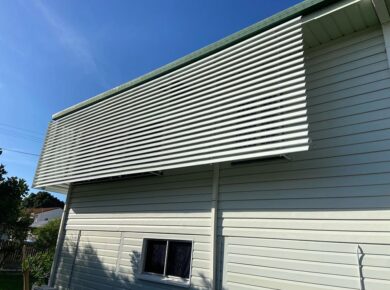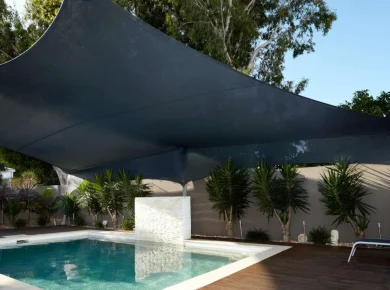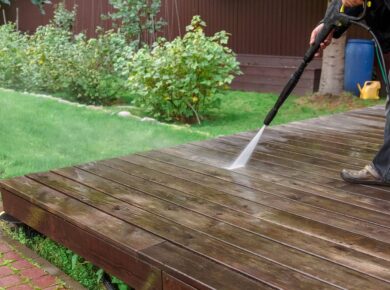Many homeowners dream of having a beautiful outdoor space, and building a deck is one of the best ways to enhance your yard. In this guide, you will learn how to construct your deck safely and efficiently, ensuring that it is both durable and aesthetic.
You’ll gain insight into crucial tools, materials, and techniques to elevate your DIY skills, transforming your vision into a reality. Let’s look into the step-by-step process to build the perfect deck for your home.
Types of Decks
Your choice of deck type can significantly impact both the aesthetics and functionality of your outdoor space. Various decking materials come with their unique benefits and challenges. Below is a comparison of some popular deck types that may fit your style and budget:
| Deck Type | Key Features |
|---|---|
| Wood Decks | Natural look, requires regular maintenance |
| Composite Decks | Durable, low-maintenance, eco-friendly |
| PVC Decks | Water-resistant, vibrant colors, no splinters |
| Aluminum Decks | Lightweight, durable, rust-proof |
| Concrete Decks | Highly durable, customizable design |
After considering your deck type, you can choose from an array of styles and materials to create the perfect outdoor retreat.
Wood Decks
There’s something timeless and inviting about wood decks. They offer a natural aesthetic that blends seamlessly with the outdoors, giving your backyard an organic feel. However, this beauty comes at a cost; wood decking requires consistent maintenance, including sealing, staining, and repairs to withstand the elements. Different species of wood can affect durability; for instance, pressure-treated pine is popular due to its affordability, while hardwoods like Ipe can be more expensive but remarkably long-lasting.
While wood decking may be susceptible to scratches, splinters, and weathering, opting for a high-quality finish and regular upkeep can dramatically extend its lifespan. In doing so, you’ll benefit from a classic choice that elevates your outdoor space and provides a cosy, welcoming ambience.
Composite Decks
You might be intrigued by composite decks, which offer an excellent blend of aesthetics and low maintenance. Made from a combination of wood fibres and recycled plastic, composite decking is designed to withstand fading, scratching, and mould.
The colour and grain options have come a long way, allowing you to achieve a realistic wood appearance that requires minimal upkeep. Unlike traditional wood, composite materials don’t need staining or sealing, making them a convenient option for busy homeowners.
Another major advantage of composite decking is its sustainability. You can feel good about using an eco-friendly choice that minimizes the demand for virgin wood. Additionally, composite decks are resistant to insects, rot, and decay, offering long-term durability without the frequent maintenance required by wood.
With the variety of colours and textures available in composite decking, you can achieve your desired look while benefiting from a material designed for longevity. This makes it a practical investment for anyone looking to enhance their outdoor living space.
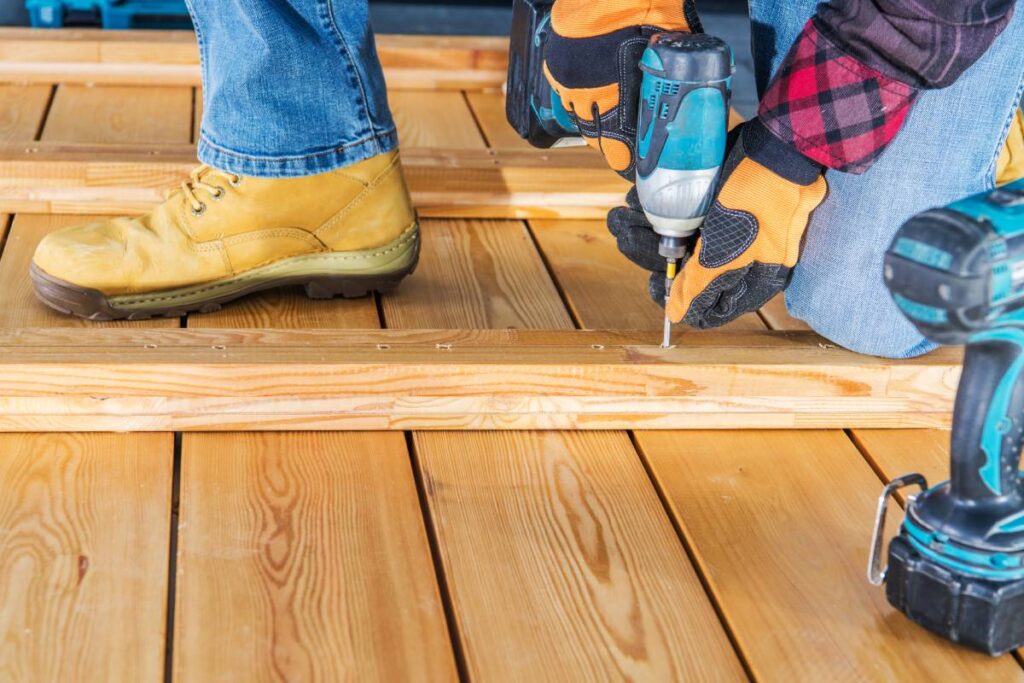
PVC Decks
You may consider PVC decks as another viable option for your outdoor deck. These decks are made entirely from plastic materials and stand out for their water resistance and lack of splinters. This makes them an exceptionally safe choice for families with children or pets. The vibrant colours and finishes available help keep your deck looking new for years while requiring less upkeep than traditional wood.
PVC decking is resistant to staining, fading, and mould growth, ensuring that your deck remains beautiful in any climate. This low-maintenance material allows you to spend more time enjoying your outdoor space and less time worrying about repairs or upkeep.
Decks made of PVC also have UV protection built-in, which ensures that the colours you choose won’t fade over time, maintaining your deck’s aesthetic appeal.
Key Factors to Consider
Now, launching on a deck-building adventure involves numerous considerations to ensure you achieve your vision while maintaining functionality and safety. Below are some key factors to keep in mind:
- Location: Identify where your deck will be situated and how that will affect design and view.
- Climate: Understand the weather conditions in your area to choose the right materials.
- Budget: Establish a budget that considers materials, labour, permits, and any additional features.
- Building Codes: Familiarize yourself with local regulations to avoid legal issues.
Perceiving the importance of these factors will help streamline your deck construction process and create a lasting outdoor space.
Location and Climate
On the path to creating your dream deck, evaluating the location and climate is crucial. The positioning of your deck affects its exposure to sunlight, wind, and moisture, all fundamental aspects to consider in the design phase. Ask yourself if you prefer a sunny spot for sunbathing or a shaded area for relaxation, as this will dictate everything from materials to overall layout.
On the other hand, understanding your local climate is equally vital. If you reside in an area prone to heavy rains, you’ll need to consider weather-resistant materials that can withstand the elements, such as composite decking. The climate also impacts the design features of your deck, including drainage systems to prevent pooling and proper ventilation to minimize mould buildup.
Budget and Materials
On the practical side, you must pay close attention to your budget and materials. Setting a clear financial limit at the beginning keeps you focused and prevents overspending. Consider how much you’re willing to invest not only in the initial build but also in the long-term maintenance. Various materials offer different price points, which could be the difference between a budget-friendly deck or an extravagant outdoor space.
Materials play a significant role in your project since they dictate not only the aesthetics but also the longevity of the structure. Choices can range from traditional wood, which may require more upkeep, to durable composite materials that combine the look of wood with low maintenance. Your choice of materials should match your lifestyle, use, and the climate in your area.
Local Building Codes
Consider the importance of adhering to local building codes when building your deck. Each municipality has specific regulations that govern setbacks, permitted materials, load capacities, and safety standards. Ignoring these codes can lead to costly fines or even the dismantling of your project, so consult with your local building department before you begin.
Understanding these local building codes means you will be fully informed of the necessary permits, inspections, and legal requirements. This knowledge will not only keep your project secure but will also enhance the credibility of your deck. Staying compliant with regulations can save you from unexpected troubles that could derail your investment.
Step-by-Step Deck Building Process
Once again, initiating a deck-building project requires a structured approach. By breaking down the process into manageable steps, you’ll ensure a successful outcome that you can be proud of. Below is a general overview of the steps involved in building a deck. Following this guide will give you clarity and confidence as you execute your vision.
| Step | Description |
|---|---|
| 1. Planning and Design | Outline your deck size, shape, and layout while considering local building codes. |
| 2. Gathering Tools and Materials | Collect all necessary tools and materials before starting the project. |
| 3. Foundation and Framing | Establish a solid foundation and frame your deck for structural integrity. |
| 4. Decking Installation | Install the decking boards to create the walking surface. |
| 5. Railing and Finishing Touches | Add railings and any finishing touches for safety and aesthetics. |
Planning and Design
There’s no doubt that the first step in building your deck is the planning and design phase. You should begin by sketching your deck idea on paper, considering factors like size, shape, and the layout of furniture. Additionally, take into account your local building codes and restrictions, which can guide the design and ensure safety.
It’s also important to visualize how the new deck will integrate with your home and landscape. Take some time to consider materials that not only meet your aesthetic preferences but also your budget and maintenance requirements. Adequate planning at this stage will ensure you move forward with clarity and purpose.
Gathering Tools and Materials
Planning leads naturally into the gathering of tools and materials. Before breaking ground, you’ll need to collect everything you require. This includes tools such as a saw, drill, and level, and materials like pressure-treated wood or composite decking, fasteners, and concrete for the foundation. Ensuring you have all your supplies on hand will save you valuable time and effort.
Utilizing a checklist can be beneficial to account for every item needed. It’s necessary to source high-quality materials that are durable and suited for outdoor use, as these components will play a significant role in the lifespan of your deck.
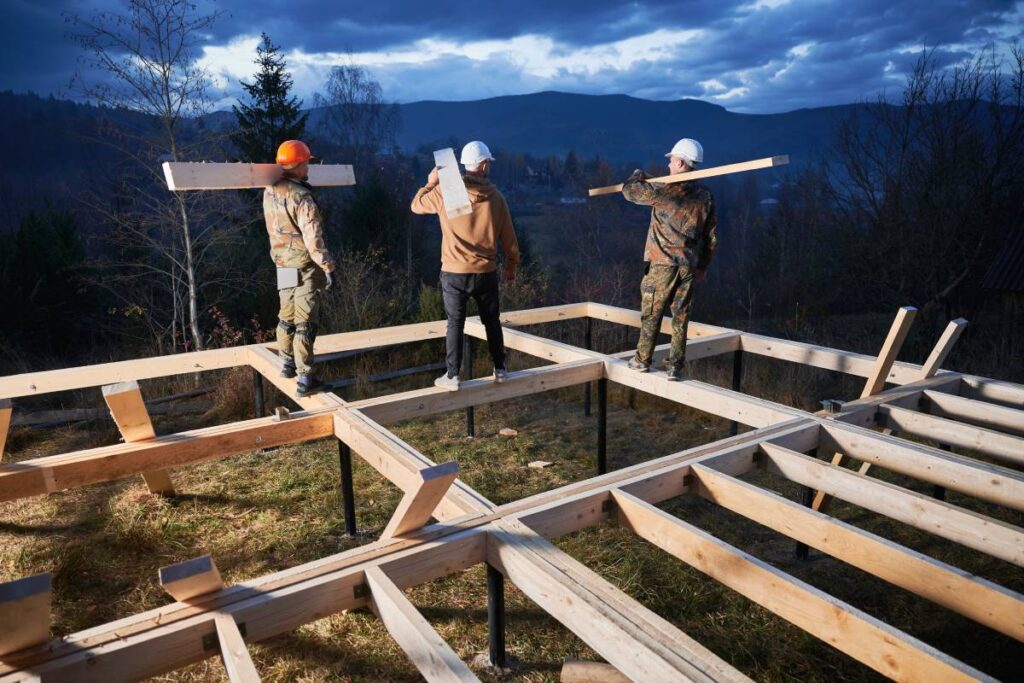
Foundation and Framing
One of the most important steps in your deck-building journey is establishing the foundation and framing. The foundation supports your entire structure, so it is necessary to prepare the ground properly and ensure it is level. Depending on your design, you may need to dig post holes and pour concrete footings or utilize concrete blocks.
Next, once the foundation is secure, begin framing your deck. This involves laying beams and joists that will support the decking material. Use a level and measuring tape frequently during this step to guarantee precision. Attention to detail during this phase will significantly enhance stability and safety.
Tools like framing squares and levels are vital during this step to ensure proper alignment and to avoid future structural issues. Always double-check your measurements and framing as you progress.
Decking Installation
For the decking installation, you will start laying down the boards across your constructed frame. It’s necessary to leave appropriate spacing between each deck board to allow for potential expansion and contraction due to weather conditions. Securing these boards with galvanized screws will prevent rust and ensure a long-lasting hold.
Once the decking is laid, you can then sand down any rough edges and prepare the surface for finishing. Transitioning from installation to finishing will be key to ensuring comfort and aesthetics in the final product.
A seamless installation can make a significant difference in the appearance of your deck. Consider arranging the boards in a pattern that appeals to your personal style and aligns with the layout of your outdoor space.
Railing and Finishing Touches
Gathering the finishing touches includes installing railings and embellishments that enhance both safety and style. Railings are generally a necessary component for any deck above a certain height and provide a barrier to prevent falls. Moreover, they can serve as a design feature that elevates the look of your finished deck.
Additional finishing touches can include lighting, post caps, or decorative skirting, transforming a basic deck into a beautiful outdoor living area. Don’t hesitate to infuse your personal style into these final aspects; it’s your deck, after all!
Deck safety should always be your priority. Make sure that the railings adhere to local building codes and are securely fastened. The final touches on your deck project will enhance both function and beauty, allowing you to enjoy your investment thoroughly.
Tips for a Successful Deck Build
Not only does building a deck require a thoughtful approach to design and construction, but it also demands attention to detail to ensure its longevity and functionality. Here are some tips to consider for a successful deck build:
- Choose the right materials for your climate.
- Ensure the foundation is properly installed and level.
- Follow local building codes and regulations.
- Use proper tools for efficient construction.
- Plan for drainage to prevent water damage.
This comprehensive approach will help you create a beautiful and durable deck that enhances your outdoor space.
Safety Precautions
To ensure your safety while building your deck, it’s necessary to follow a set of safety protocols. Always wear appropriate safety gear, such as gloves, goggles, and ear protection. Familiarize yourself with your tools and read the instructions carefully before use to avoid injuries. Additionally, if you’re working at heights, make sure to use proper fall protection equipment.
Furthermore, keep your work area clean and organized to prevent accidents. Be aware of your surroundings, especially if you’re working with electricity or near heavy machinery. Adhering to these safety precautions creates a secure environment for you and anyone assisting you in your deck project.
Maintenance and Longevity
Assuming that your deck is constructed correctly, maintaining its condition is vital for its longevity. Regularly check for signs of wear, such as loose boards, splintering, or signs of decay. Clean your deck periodically to remove dirt, mould, and mildew, which can deteriorate the material over time. Consider applying a sealant every 2-3 years, depending on the type of wood or material you’ve chosen.
Tips for maintaining your deck involve using a pressure washer or a mild detergent solution for cleaning. Regularly inspect the railings and stairs for stability, and address any issues promptly. Additionally, ensure that the surface is sealed to protect against moisture and UV rays.
A well-maintained deck not only enhances the beauty of your outdoor space but also significantly extends the lifespan of your structure. This can save you time and money in the long run, ultimately allowing you to enjoy your outdoor space for years to come.
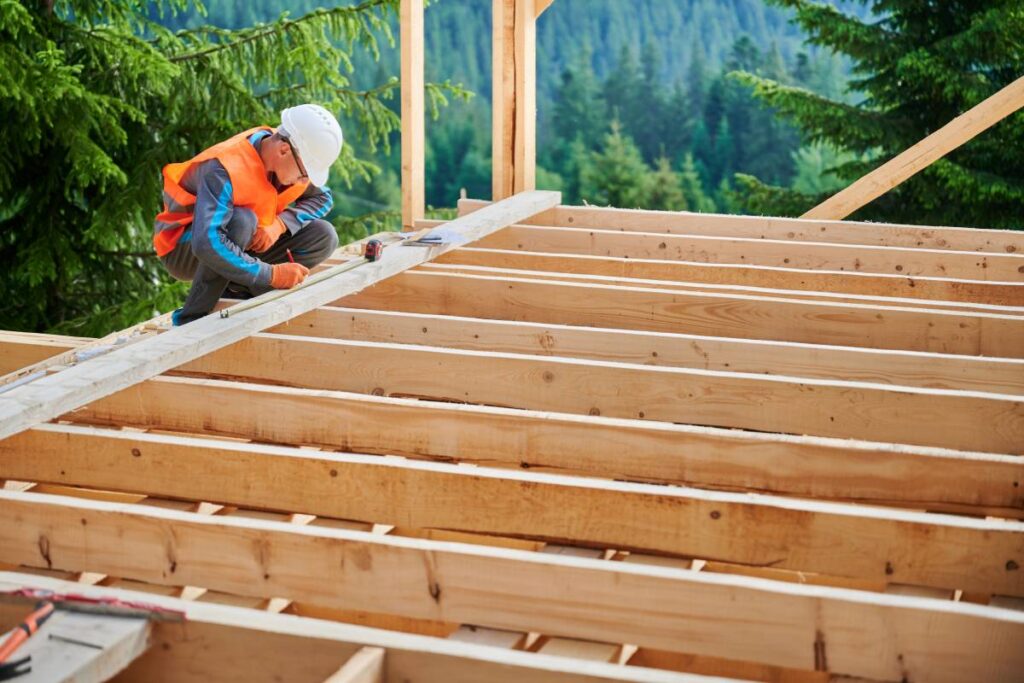
Pros and Cons of Different Deck Materials
Keep in mind that choosing the right material for your deck is important, as it impacts not only the aesthetics but also the longevity and maintenance of your outdoor space. Below is a comparison of the pros and cons of various decking materials in order to help you make a well-informed decision.
| Material | Pros and Cons |
|---|---|
| Wood | Pros: Beautiful appearance, natural feel; Cons: Requires regular maintenance and treatment. |
| Composite | Pros: Low maintenance, resistant to decay; Cons: Can be more expensive initially. |
| Vinyl | Pros: Durable and easy to clean; Cons: Can fade and may not feel as traditional. |
| Aluminum | Pros: Extremely durable, fire-resistant; Cons: Can be too hot in direct sunlight. |
| Concrete | Pros: Lasting, low maintenance; Cons: Can crack and may not offer a warm look. |
| PVC | Pros: Stain resistant, does not require sealing; Cons: Limited colour options. |
| Pressure-Treated Lumber | Pros: Affordable, readily available; Cons: Requires regular sealing and staining. |
| Ipe | Pros: Extremely durable and beautiful; Cons: Expensive and heavy to work with. |
| Rubber | Pros: Great for outdoor spaces with moisture; Cons: Can degrade in UV light. |
| Teak | Pros: Natural oils provide resistance to weather; Cons: High cost and often sourced unsustainably. |
Benefits of Wood
Materials such as wood bring a unique charm and warmth to your deck, which many synthetic alternatives cannot replicate. If you prioritize aesthetics and enjoy a natural look, using hardwood or softwood options can create a beautiful outdoor space that complements your home. Wood is also readily available and can be easier to work with for DIY projects, allowing you potential savings on labour costs.
Furthermore, wood decking can be less expensive upfront compared to composite or PVC options, which might make it a more appealing choice for those on a tighter budget. The natural variations in wood textures and colours mean that you can achieve a customized look for your deck, creating an inviting atmosphere for gatherings with family and friends. However, you should weigh these benefits against the necessary upkeep that wood requires to maintain its beauty.
Advantages of Composites
Clearly, composite decking offers a variety of advantages that can make it a preferable option for many homeowners. For one, composite materials are designed to be highly resistant to fading, rot, and insects, lasting significantly longer than traditional wood. Not only does this reduce your maintenance workload, but it also means you won’t have to replace boards as frequently, making it a cost-effective choice in the long run.
Additionally, composite decks come in an array of colours and textures, allowing you to mimic the appearance of wood without the associated maintenance. This adaptability makes it easier for you to find the perfect match for your home while ensuring a durable and functional outdoor space. Furthermore, many composite brands incorporate recycled materials, making your choice an environmentally friendly one.
Cons are something you should also consider when evaluating composite decking. Although it may be less expensive over time, the initial investment can be higher than that of untreated wood, which might be a critical factor in your decision-making process.
Disadvantages to Consider
Disadvantages abound when it comes to selecting decking materials, particularly regarding the upkeep and longevity of your choice. Composite decking may not always offer the same level of sturdiness as high-quality hardwoods, leading some consumers to believe it lacks a solid bang for your buck. Additionally, while composites resist fading better than wood, they don’t eliminate the risk of discolouration over time, particularly in extreme weather conditions.
Moreover, although wood requires maintenance, such as staining and sealing, this maintenance helps ensure its long-term durability. Composite materials, while low maintenance, may face issues related to expansion and contraction in temperature fluctuations, leading you to experience warping or buckling if not properly installed. It’s vital to carefully assess these potential disadvantages against the many benefits of each material.
Pros should always guide your decision when it comes to selecting the right decking material for your project. Balancing the aesthetic appeal, long-term maintenance, and cost will lead you to a well-informed, satisfying choice that enhances your outdoor living experience.
To Wrap Up
Presently, building a deck step by step is a rewarding project that can enhance your outdoor living space and increase your home’s value. By meticulously planning, selecting the right materials, and following the outlined steps, you can create a durable and aesthetically pleasing deck that suits your needs.
You’ve learned the importance of obtaining the proper permits, choosing quality lumber, and installing components securely, which all contribute to a safe and long-lasting structure.
As you move forward with your deck building project, always pay attention to local building codes and weather conditions, as these can impact your construction timeline and safety. With dedication and careful execution, you can transform your backyard into a beautiful retreat where you can enjoy gatherings with family and friends or simply unwind in the beauty of your surroundings.
Your effort will not only result in a functional space but also in a personal achievement that showcases your skills in home improvement.
